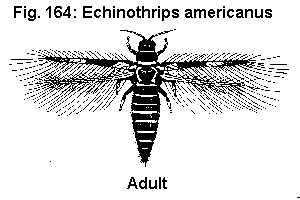 Fig. 164: ,
adult, Echinothrips americanus Morgan, Thripidae,
THYSANOPTERA
Fig. 164: ,
adult, Echinothrips americanus Morgan, Thripidae,
THYSANOPTERA Return to: CFREC Home Page
DESCRIPTION
Adult- The adult female Echinothrips americanus is about 1.6 mm long and the male about 1.3 mm long. The general body color is dark brown with red between the abdominal segments. Segments 1 and 2 of the antenna are dark brown, 3 and 4 lighter. Forewings are pale gray at base, middle, and tip with light brown in between.
Egg- Laid in plant tissue, elongate and clear to white.
Larva- Immediately after hatch the larvae are clear but they change to white and then become light or pale yellow after feeding. The second-stage larvae become cream colored before molting to prepupae.
4 Pupa and Prepupa- Both are found on leaf tissue and move only when disturbed. Prepupa is white with short wing pads and antennae extend forward. Pupa is white with long wing pads and the antennae bend back over body.
 Fig. 164: ,
adult, Echinothrips americanus Morgan, Thripidae,
THYSANOPTERA
Fig. 164: ,
adult, Echinothrips americanus Morgan, Thripidae,
THYSANOPTERA
Distribution- Echinothrips americanus has a range over most of the eastern United States. It has been reported as a pest of nursery and landscape plants in the southern part of its range and as a greenhouse pest on several plants.
Host Plant- This thrips will feed on both the upper and lower leaf surfaces but is usually more common on the lower surface. They have been found and reproduce on most ornamental plants tested and many of the common weed species of Georgia. In an experiment in Georgia, out of 51 species of cultivated plants and 75 native plants studied, feeding and reproduction was observed on 40 cultivated and 59 native species. Of all the greenhouse host plants; poinsettias, Irish shamrock, and impatiens are the most common hosts in Georgia. They also have been common on chrysanthemum foliage and flowers. They also have been a pest on woody ornamentals.
Damage- This thrips feeds on leaf tissue and the damage is very similar to typical mite damage with light spots on the leaf. Their numerous but shallow punctures result in injured tissue with a shrunken appearance, and the light color is a result of the cell constituents, including chlorophyll, being removed. Infested leaves will have numerous black specs on them that are fecal drippings of the thrips. They also will feed on parts of the flower.
Life History- Female E. americanus deposits eggs separately in slits in the leaf tissue. Eggs were deposited at random on the leaf surface. Developmental time depended on temperature, at 15°C the egg stage averaged 15.5 days and the immatures took 18.4 days for a total of 33.9 days. Under warmer conditions development was faster, at 30°C the egg stage took 5.8 days and the immatures only 5.6 days for a total of 11.4 days from egg to adult. Developmental time varied with different host species. All stages were present throughout the year in the greenhouse. Adults and immatures were not very active and would remain in the same area of a leaf for days if not disturbed.
Different populations of this thrips have expressed different susceptibility to insecticides. Greenhouse populations in Georgia have been susceptible to most insecticides. There have been reports of populations on woody nursery plants that were difficult to control. For specific insecticides and rates, consult current Cooperative Extension Service publications on ornamental plant pests.
University of Florida/IFAS Reference to Pest Control Guides